Failure and Seepage Characteristics of Gas-Bearing Coal under Accelerated Loading and Unloading Conditions
Abstract
:1. Introduction
2. Experimental Study
2.1. Sample Preparation and Experimental Program
2.2. Experimental Results
2.2.1. Strength Characteristics
2.2.2. Permeability Characteristics
2.2.3. Failure Characteristics
3. Theoretical Study
3.1. Permeability Model
3.2. Model Verification
4. Discussion
5. Conclusions
Author Contributions
Funding
Acknowledgments
Conflicts of Interest
References
- Conti, J.; Holtberg, P.; Diefenderfer, J.; LaRose, A.; Turnure, J.T.; Westfall, L. International Energy Outlook 2016 with Projections to 2040; No. DOE/EIA-0484; Office of Energy Analysis, USDOE Energy Information Administration (EIA): Washington, DC, USA, 2016.
- Lin, J.; Fridley, D.; Lu, H.; Price, L.; Zhou, N. Has coal use peaked in China: Near-term trends in China’s coal consumption. Energy Policy 2018, 123, 208–214. [Google Scholar] [CrossRef]
- Du, F.; Wang, K. Unstable failure of gas-bearing coal-rock combination bodies: Insights from physical experiments and numerical simulations. Process Saf. Environ. Protect. 2019, 129, 264–279. [Google Scholar] [CrossRef]
- Iannacchione, A.; Tadolini, S. Occurrence, predication, and control of coal burst events in the U.S. Int. J. Min. Sci. Technol. 2016, 26, 39–46. [Google Scholar] [CrossRef]
- Lu, C.; Dou, L.; Zhang, N.; Xue, J.; Liu, G. Microseismic and acoustic emission effect on gas outburst hazard triggered by shock wave: A case study. Nat. Hazards 2014, 73, 1715–1731. [Google Scholar] [CrossRef]
- Wang, G.; Chu, X.; Yang, X. Numerical simulation of gas flow in artificial fracture coal by three-dimensional reconstruction based on computed tomography. J. Nat. Gas Sci. Eng. 2016, 34, 823–831. [Google Scholar] [CrossRef]
- Fan, C.; Elsworth, D.; Li, S.; Zhou, L.; Yang, Z.; Song, Y. Thermo-hydro-mechanical-chemical couplings controlling CH4 production and CO2 sequestration in enhanced coalbed methane recovery. Energy 2019, 173, 1054–1077. [Google Scholar] [CrossRef]
- Tu, Q.; Cheng, Y.; Liu, Q.; Guo, P.; Wang, L.; Li, W.; Jiang, J. Investigation of the formation mechanism of coal spallation through the cross-coupling relations of multiple physical processes. Int. J. Rock Mech. Min. Sci. 2018, 105, 133–144. [Google Scholar] [CrossRef]
- Wang, K.; Du, F.; Wang, G. Investigation of gas pressure and temperature effects on the permeability and steady-state time of Chinese anthracite coal: An experimental study. J. Nat. Gas Sci. Eng. 2017, 40, 179–188. [Google Scholar] [CrossRef]
- Aziz, N.I.; Li, W.M. The effect of sorbed gas on the strength of coal-an experimental study. Geotech. Geol. Eng. 1999, 17, 387–402. [Google Scholar] [CrossRef]
- Kasani, H.A.; Chalaturnyk, R.J. Influence of high pressure and temperature on the mechanical behavior and permeability of a fractured coal. Energies 2017, 10, 854. [Google Scholar] [CrossRef]
- Masoudian, M.S.; Airey, D.W.; El-Zein, A. Experimental investigations on the effect of CO2 on mechanics of coal. Int. J. Coal Geol. 2014, 128, 12–23. [Google Scholar] [CrossRef]
- Siriwardane, H.; Haljasmaa, I.; Mclendon, R.; Irdi, G.; Soong, Y.; Bromhal, G. Influence of carbon dioxide on coal permeability determined by pressure transient methods. Int. J. Coal Geol. 2009, 77, 109–118. [Google Scholar] [CrossRef]
- Gentzis, T.; Deisman, N.; Chalaturnyk, R.J. Geomechanical properties and permeability of coals from the Foothills and Mountain regions of western Canada. Int. J. Coal Geol 2007, 69, 153–164. [Google Scholar] [CrossRef]
- Wang, D.; Lv, R.; Wei, J.; Fu, Q.; Wang, Y.; Zhang, P.; Yu, C.; Yao, B. An experimental study of seepage properties of gas-saturated coal under different loading conditions. Energy Sci. Eng. 2019, 7, 799–808. [Google Scholar] [CrossRef]
- Zhang, Q.; Fan, X.; Liang, Y.; Li, M.; Li, G.; Ma, T.; Nie, W. Mechanical behavior and permeability evolution of reconstituted coal samples under various unloading confining pressures implications for wellbore stability analysis. Energies 2017, 10, 292. [Google Scholar] [CrossRef]
- Zhang, C.; Zhang, L. Permeability characteristics of broken coal and rock under cyclic loading and unloading. Nat. Resour. Res. 2019, 28, 1055–1069. [Google Scholar] [CrossRef]
- Guo, J.; Liu, J.; Li, Q.; Chen, X.; Chen, Z.; Huang, B.; Chen, S. Variation law of coal permeability under cyclic loading and unloading. Therm. Sci. 2019, 23, 1487–1494. [Google Scholar] [CrossRef]
- Li, Q.; Liang, Y.; Zou, Q. Seepage and damage evolution characteristics of gas-bearing coal under different cyclic loading-unloading stress paths. Processes 2018, 6, 190. [Google Scholar] [CrossRef]
- Xue, D.; Zhou, H.; Wang, Z.; Ren, W.; Zhang, M.; Liu, Y. Failure mechanism and mining induced mechanical properties of coal under different loading rates. J. China Coal Soc. 2016, 41, 595–602. [Google Scholar]
- Xue, Y.; Ranjith, P.G.; Gao, F.; Zhang, D.; Cheng, H.; Chong, Z.; Hou, P. Mechanical behaviour and permeability evolution of gas-containing coal from unloading confining pressure tests. J. Nat. Gas Sci. Eng. 2017, 40, 336–346. [Google Scholar] [CrossRef]
- Jiang, C.; Liu, X.; Li, M.; Yu, H.; Duan, M. A new loading–unloading experimental method for simulating the change of mining-induced stress. R. Soc. Open Sci. 2019, 6, 181964. [Google Scholar] [CrossRef] [PubMed]
- Jasinge, D.; Ranjith, P.G.; Choi, X.; Fernando, J. Investigation of the influence of coal swelling on permeability characteristics using natural brown coal and reconstituted brown coal specimens. Energy 2012, 39, 303–309. [Google Scholar] [CrossRef]
- Liu, Q.; Cheng, Y.; Ren, T.; Jing, H.; Tu, Q.; Dong, J. Experimental observations of matrix swelling area propagation on permeability evolution using natural and reconstituted samples. J. Nat. Gas Sci. Eng. 2016, 34, 680–688. [Google Scholar] [CrossRef]
- Du, F.; Wang, K.; Wang, G.; Jiang, Y.; Xin, C.; Zhang, X. Investigation on acoustic emission characteristics during deformation and failure of gas-bearing coal-rock combined bodies. J. Loss Prev. Process Ind. 2018, 55, 253–266. [Google Scholar] [CrossRef]
- Busch, A.; Gensterblum, Y. CBM and CO2-ECBM related sorption processes in coal: A review. Int. J. Coal Geol. 2011, 87, 49–71. [Google Scholar] [CrossRef]
- Day, S.; Fry, R.; Sakurovs, R. Swelling of coal in carbon dioxide, methane and their mixtures. Int. J. Coal Geol. 2012, 93, 40–48. [Google Scholar] [CrossRef]
- Gensterblum, Y.; Merkel, A.; Busch, A.; Krooss, B.M. High-pressure CH4, and CO2, sorption isotherms as a function of coal maturity and the influence of moisture. Int. J. Coal Geol. 2013, 118, 45–57. [Google Scholar] [CrossRef]
- Wang, K.; Du, F.; Zhang, X.; Wang, L.; Xin, C. Mechanical properties and permeability evolution in gas-bearing coal—rock combination body under triaxial conditions. Environ. Earth Sci. 2017, 76, 815. [Google Scholar] [CrossRef]
- Wang, J.; Shao, T.; Zhao, H. Experimental study of effect of gas on mechanical properties of outburst coal. J. Min. Saf. Eng. 2011, 28, 391–394. [Google Scholar]
- Li, J.; Liu, J.; Zhang, Z.; Pei, J.; Liu, X.; Zhang, R. Investigation on mechanical properties and permeability of coal under gas pressure. J. China U. Min. Technol. 2013, 42, 954–960. [Google Scholar]
- Majewska, Z.; Majewski, S.; Ziętek, J. Swelling of coal induced by cyclic sorption/desorption of gas: Experimental observations indicating changes in coal structure due to sorption of CO2 and CH4. Int. J. Coal Geol. 2010, 83, 475–483. [Google Scholar] [CrossRef]
- Viete, D.R.; Ranjith, P.G. The mechanical behaviour of coal with respect to CO2 sequestration in deep coal seams. Fuel 2007, 86, 2667–2671. [Google Scholar] [CrossRef]
- Wang, K.; Du, F.; Wang, G. The influence of methane and CO2 adsorption on the functional groups of coals: Insights from a Fourier transform infrared investigation. J. Nat. Gas Sci. Eng. 2017, 45, 358–367. [Google Scholar] [CrossRef]
- Chilingar, G.V. Relationship between porosity, permeability, and grain-size distribution of sands and sandstones. Dev. Sedimentol. 1964, 1, 71–75. [Google Scholar]
- Liu, J.; Chen, Z.; Elsworth, D.; Miao, X.; Mao, X. Evaluation of stress-controlled coal swelling processes. Int. J. Coal Geol. 2010, 83, 446–455. [Google Scholar] [CrossRef]
- Pan, Z.; Connell, L.D. Modelling permeability for coal reservoirs: A review of analytical models and testing data. Int. J. Coal Geol. 2012, 92, 1–44. [Google Scholar] [CrossRef]
- Palmer, I.; Mansoori, J. How permeability depends on stress and pore pressure in coalbeds: A new model. Soc. Petrol. Eng. 1998, 1, 539–543. [Google Scholar] [CrossRef]
- Robertson, E.P.; Christiansen, R.L. Modeling permeability in coal using sorption-induced strain data. In Proceedings of the 2005 SPE Annual Technical Conference and Exhibition, Dallas, TX, USA, 9–12 October 2005. SPE 4133–4142. [Google Scholar]
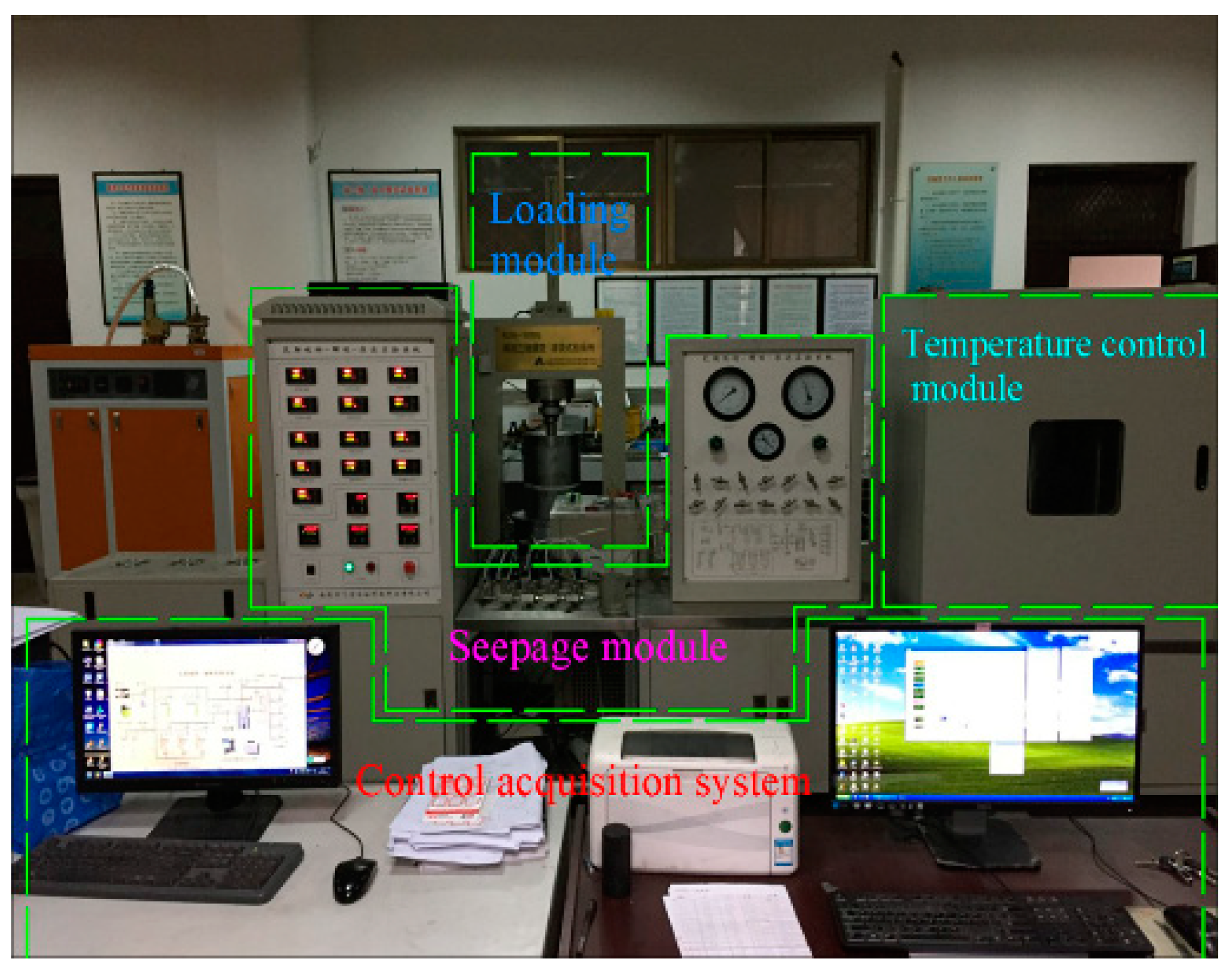



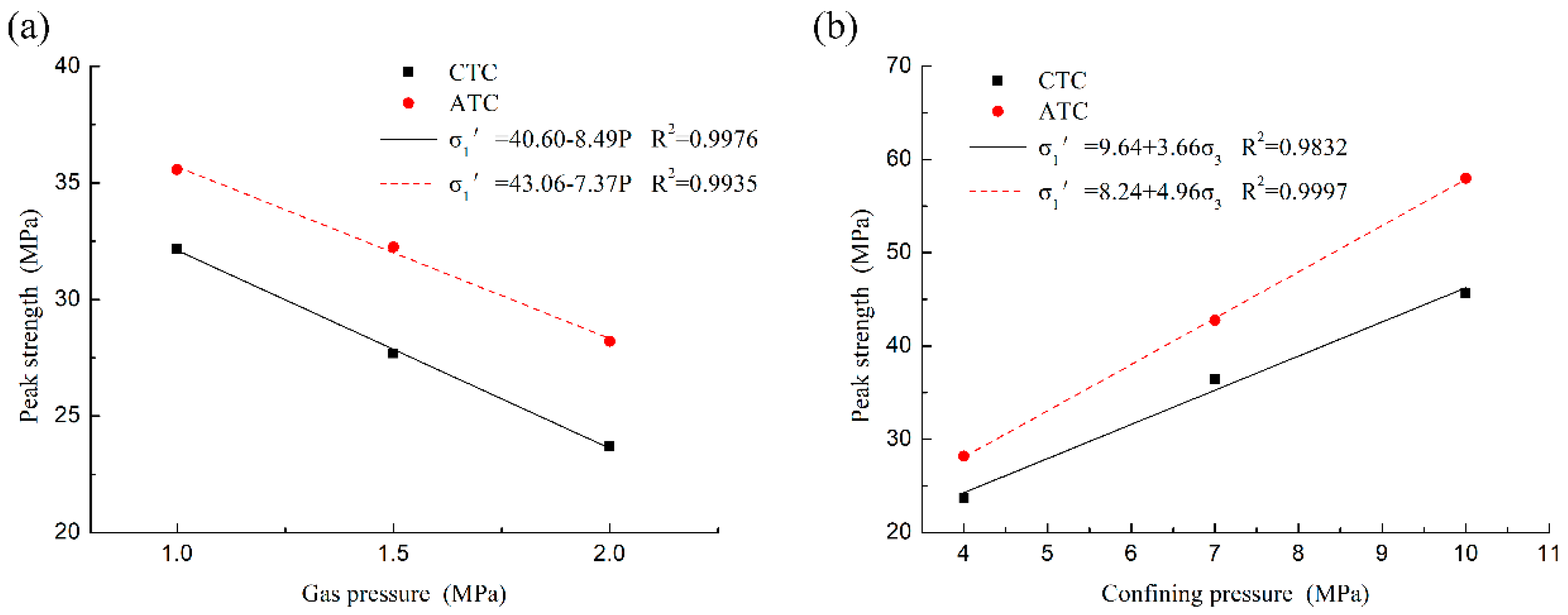

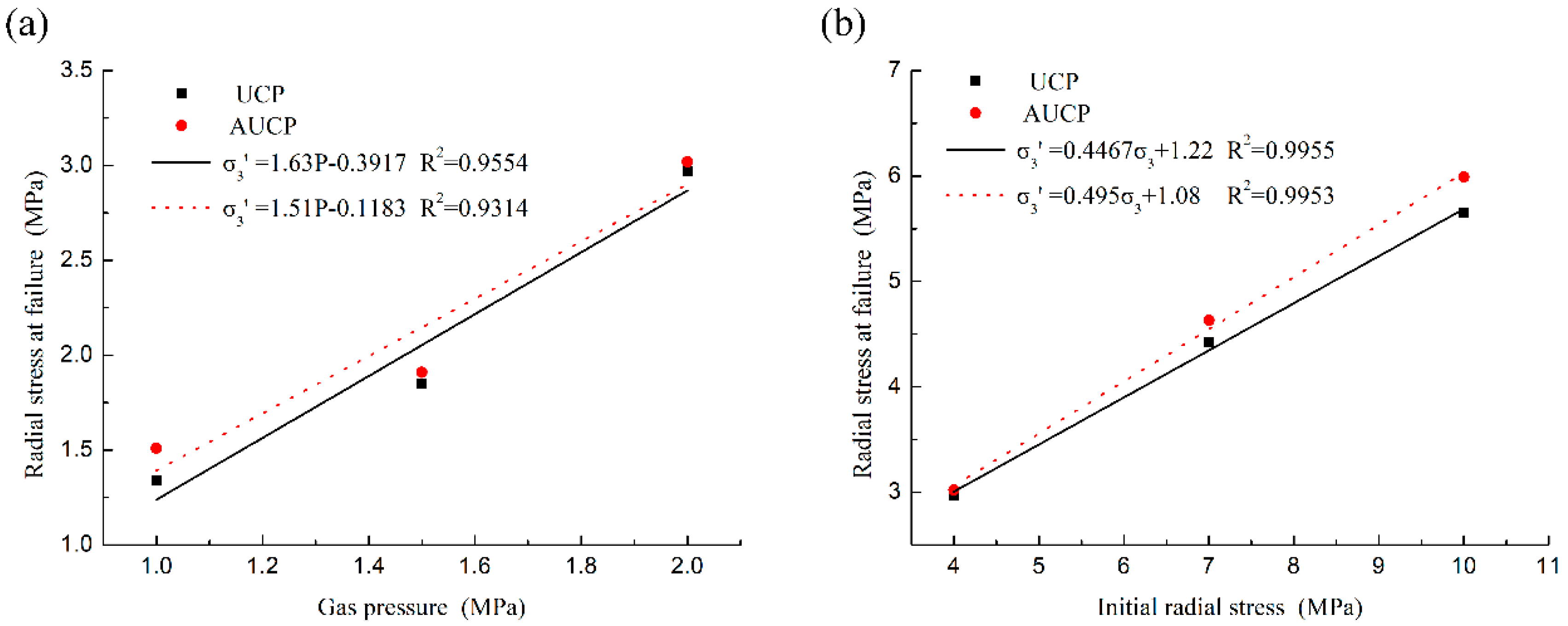



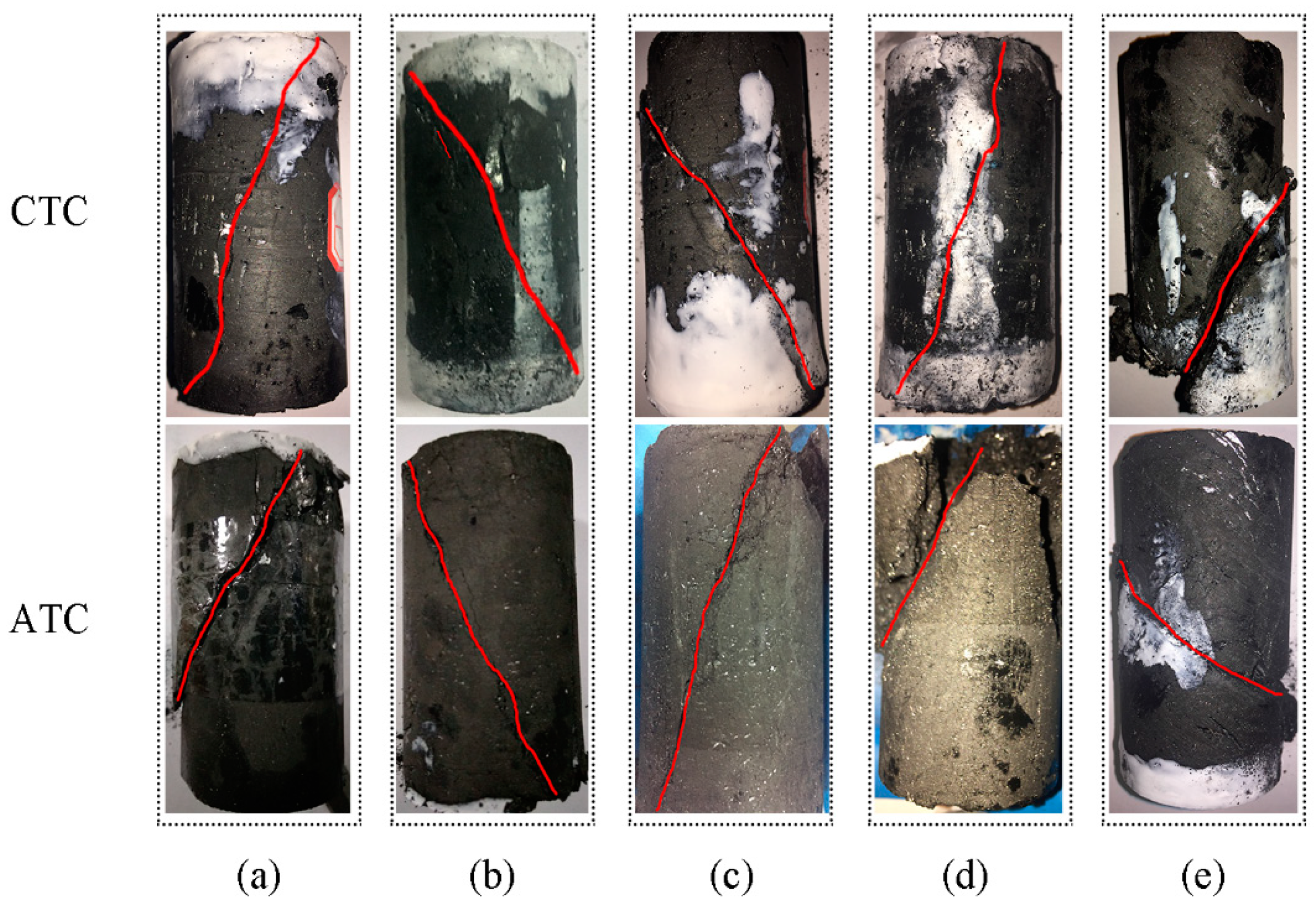

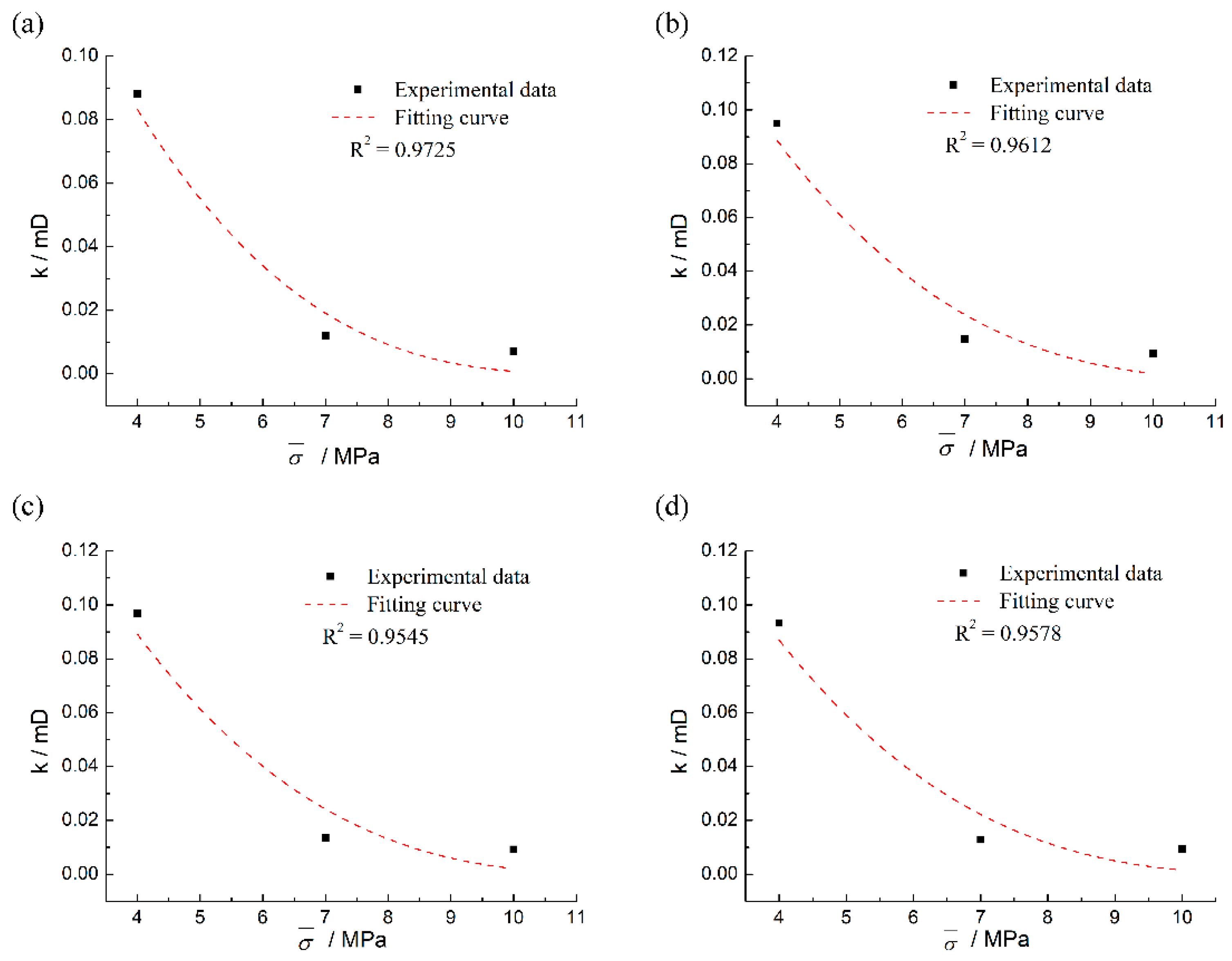

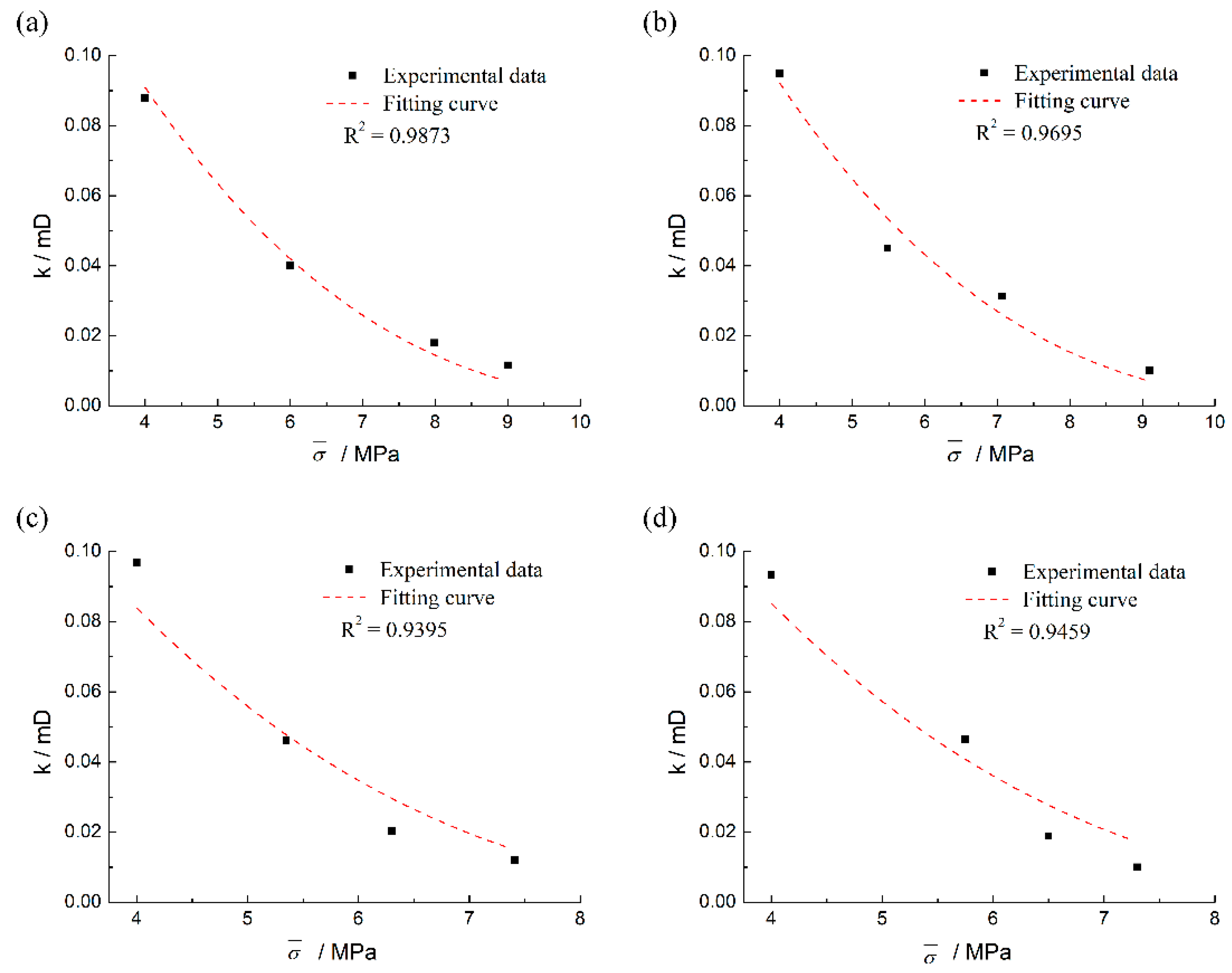
| Paths | No. | σ3/MPa | P/MPa | V/N·s-1 | σ1’/MPa | σr /MPa | σ/MPa | n/% | t/s |
|---|---|---|---|---|---|---|---|---|---|
| CTC | 1-1 | 4 | 1 | 50 | 32.19 | 23.10 | 9.09 | 28.24 | 1106 |
| 1-2 | 4 | 1.5 | 50 | 27.69 | 20.81 | 6.88 | 24.85 | 930 | |
| 1-3 | 4 | 2 | 50 | 23.70 | 17.76 | 5.94 | 25.06 | 773 | |
| 1-4 | 7 | 2 | 50 | 36.43 | 31.59 | 4.84 | 13.29 | 1155 | |
| 1-5 | 10 | 2 | 50 | 45.66 | 37.83 | 7.83 | 17.15 | 1400 | |
| ATC | 2-1 | 4 | 1 | 50/200 | 35.57 | 23.41 | 12.16 | 34.19 | 571 |
| 2-2 | 4 | 1.5 | 50/200 | 32.25 | 24.31 | 7.94 | 24.62 | 486 | |
| 2-3 | 4 | 2 | 50/200 | 28.20 | 20.35 | 7.85 | 27.84 | 399 | |
| 2-4 | 7 | 2 | 50/200 | 42.78 | 33.85 | 8.93 | 20.87 | 574 | |
| 2-5 | 10 | 2 | 50/200 | 57.98 | 38.03 | 19.95 | 34.41 | 714 |
| Paths | N0. | σ3/MPa | P/MPa | σ1″/MPa | V’/N·s-1 | σ3’/MPa | σ’/MPa | N/% | t’/s |
|---|---|---|---|---|---|---|---|---|---|
| UCP | 3-1 | 4 | 1 | 20.4 | 20 | 1.34 | 2.66 | 66.50 | 904 |
| 3-2 | 4 | 1.5 | 17.5 | 20 | 1.85 | 2.15 | 53.75 | 740 | |
| 3-3 | 4 | 2 | 14.9 | 20 | 2.97 | 1.03 | 25.75 | 528 | |
| 3-4 | 7 | 2 | 23.1 | 20 | 4.42 | 2.58 | 36.86 | 884 | |
| 3-5 | 10 | 2 | 28.4 | 20 | 5.65 | 4.35 | 43.50 | 1148 | |
| AUCP | 4-1 | 4 | 1 | 20.4 | 20/80 | 1.51 | 2.49 | 62.25 | 734 |
| 4-2 | 4 | 1.5 | 17.5 | 20/80 | 1.91 | 2.09 | 52.25 | 610 | |
| 4-3 | 4 | 2 | 14.9 | 20/80 | 3.02 | 0.98 | 24.50 | 481 | |
| 4-4 | 7 | 2 | 23.1 | 20/80 | 4.63 | 2.37 | 33.86 | 741 | |
| 4-5 | 10 | 2 | 28.4 | 20/80 | 5.99 | 4.01 | 40.10 | 893 |
| Parameters | Symbol | Value |
|---|---|---|
| Elastic modulus (MPa) | 2960 | |
| Poisson’s ratio | 0.4 | |
| Bulk modulus (MPa) | 4933.33 | |
| Bulk modulus of coal skeleton (MPa) | 14,800 | |
| Initial porosity | 0.04 | |
| Initial permeability (mD) | 0.2 | |
| Langmuir volumetric strain | 0.004 | |
| Langmuir pressure (MPa) | 1 |
© 2019 by the authors. Licensee MDPI, Basel, Switzerland. This article is an open access article distributed under the terms and conditions of the Creative Commons Attribution (CC BY) license (http://creativecommons.org/licenses/by/4.0/).
Share and Cite
Zhang, X.; Wang, K.; Du, F.; Lou, Z.; Wang, G. Failure and Seepage Characteristics of Gas-Bearing Coal under Accelerated Loading and Unloading Conditions. Appl. Sci. 2019, 9, 5141. https://doi.org/10.3390/app9235141
Zhang X, Wang K, Du F, Lou Z, Wang G. Failure and Seepage Characteristics of Gas-Bearing Coal under Accelerated Loading and Unloading Conditions. Applied Sciences. 2019; 9(23):5141. https://doi.org/10.3390/app9235141
Chicago/Turabian StyleZhang, Xiang, Kai Wang, Feng Du, Zhen Lou, and Gongda Wang. 2019. "Failure and Seepage Characteristics of Gas-Bearing Coal under Accelerated Loading and Unloading Conditions" Applied Sciences 9, no. 23: 5141. https://doi.org/10.3390/app9235141




